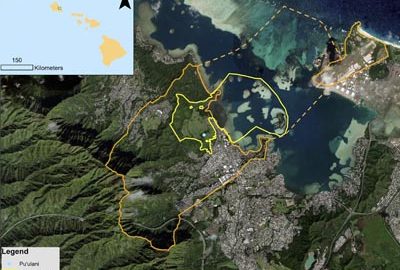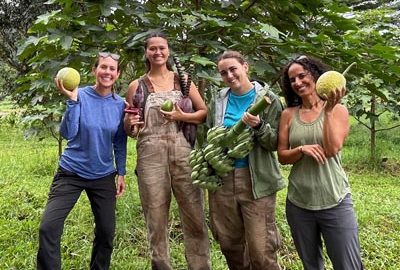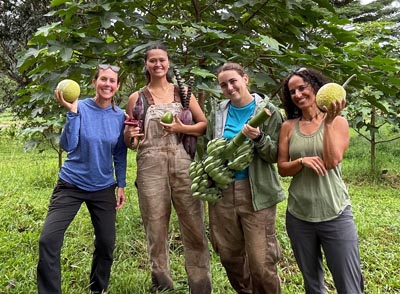 In 2018, the University of Hawai‘i at Mānoa (UHM) and Kāko‘o ‘Ōiwi, a community-based organization, have worked together to transition a primarily non-native forest to a culturally and ecologically valuable agroforest at Pu‘ulani (heavenly ridge) in Heʻeia, O‘ahu. The plants selected where chosen to “feed” the community in multiple ways and include diverse species for food, lei, ceremony, and medicine.
In 2018, the University of Hawai‘i at Mānoa (UHM) and Kāko‘o ‘Ōiwi, a community-based organization, have worked together to transition a primarily non-native forest to a culturally and ecologically valuable agroforest at Pu‘ulani (heavenly ridge) in Heʻeia, O‘ahu. The plants selected where chosen to “feed” the community in multiple ways and include diverse species for food, lei, ceremony, and medicine.
Interdisciplinary research at this site aims to help understand how restoration influences the social-ecological system and includes a focus on: (1) soil health and microbes; (2) carbon storage (3) growth, survival, and understory cover of the plants; and (4) community benefits. Research results help to support management at Puʻulani and expansion of restoration across Kākoʻo ʻŌiwi mauka lands and other sites.
The interdisciplinary research team from UHM includes WRRC and UHERO (Leah Bremer), the School of Life Sciences (Zoe Hastings, Tamara Ticktin, Tressa Hoppe, Maile Wong), the Department of Natural Resources and Environmental Management (Clay Trauernicht, Susan Crow, Angel Melone), Pacific Bioscience Research Center (Kiana Frank), and the He‘eia National Estuarine Research Reserve (Kiana Frank). Puʻulani is currently funded by the UH Sea Grant College Program.
Photo caption: Pu‘ulani restoration site within Kāko‘o ‘Ōiwi, He‘ieia, O‘ahu. (Source: Melone et al. 2021)
 Cover photo: UH Pu’ulani research team with their bountiful harvest of ‘ulu, limes, and banana. (from left, Leah Bemer, Maile Wong, Tressa Hoppe, Tamara Ticktin).
Cover photo: UH Pu’ulani research team with their bountiful harvest of ‘ulu, limes, and banana. (from left, Leah Bemer, Maile Wong, Tressa Hoppe, Tamara Ticktin).
Visit UHERO Blog: https://uhero.hawaii.edu/pu%ca%bbulani-biocultural-restoration-of-agroforestry-in-he%ca%bbeia-o%ca%bbahu/ | UH News (March 15, 2023): https://www.hawaii.edu/news/2023/03/15/restoring-puulani/ | Journal Paper (Agriculture 11(3): 189, 2021 https://doi.org/10.3390/agriculture11030189)
